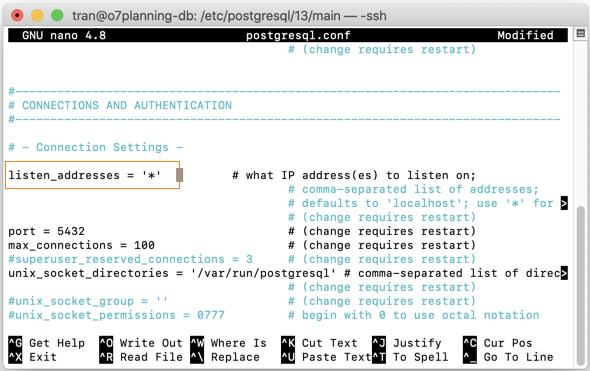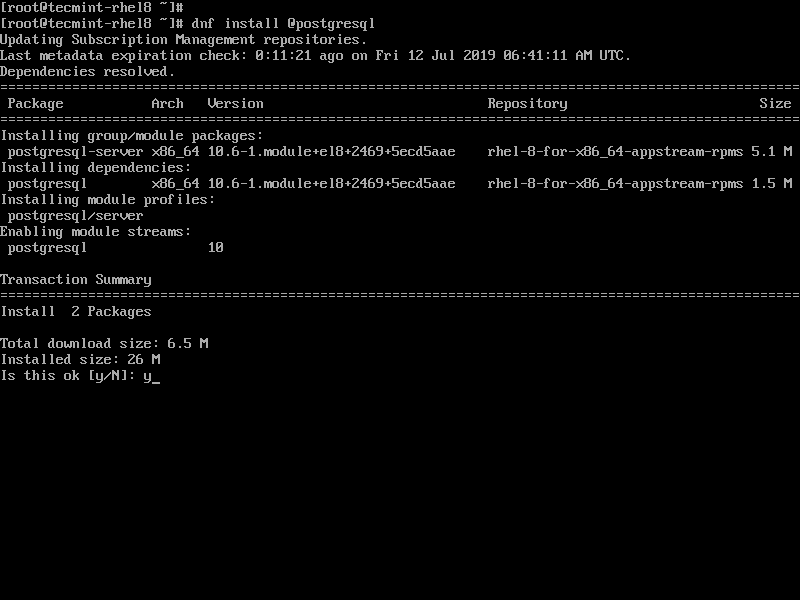

- #CONFIGURE POSTGRESQL UNIX SOCKET HOW TO#
- #CONFIGURE POSTGRESQL UNIX SOCKET UPDATE#
Working with dates and times in MongoDB.Introduction to MongoDB connection URIs.
#CONFIGURE POSTGRESQL UNIX SOCKET HOW TO#
How to query and filter documents in MongoDB.How to manage databases and collections in MongoDB.How to manage authorization and privileges in MongoDB.How to manage users and authentication in MongoDB.
 Introduction to provisioning MongoDB Atlas. How to export database and table schemas in SQLite.
Introduction to provisioning MongoDB Atlas. How to export database and table schemas in SQLite. #CONFIGURE POSTGRESQL UNIX SOCKET UPDATE#
How to update existing data with SQLite.How to perform basic queries with `SELECT` with SQLite.Inserting and deleting data with SQLite.Creating and deleting databases and tables with SQLite.An introduction to MySQL column and table constraints.How to create and delete databases and tables in MySQL.How to manage privileges with roles in MySQL.How to use `GRANT` and `REVOKE` to manage privileges in MySQL.How to manage users and authentication in MySQL.An introduction to authorization and authentication in MySQL.An introduction to PostgreSQL column and table constraints.An introduction to PostgreSQL data types.How to create and delete databases and tables in PostgreSQL.Managing privileges in PostgreSQL with grant and revoke.Configuring PostgreSQL user authentication.Managing roles and role attributes in PostgreSQL.An introduction to authorization and authentication in PostgreSQL.How to configure a PostgreSQL database on RDS.Comparing relational and document databases.Glossary of common database terminology.Comparing database types: how database types evolved to meet different needs.

The tablespaces are now created and you can continue with the master installation.
Run this script with any PostgreSQL tool capable of running scripts, or use the psql -U postgres -W -f //Create_TS.postgres.sql command line. If a user other than postgres is used, this user name must be created manually. &2 with the DatabaseBmcdbUser, that is, the user name that is used to connect to the BMC Client Management database. &1 with the path to the BMC Client Management database folders, for example, if the path previously defined was /var/lib/pgsql/data, &1 should be replaced with /var/lib/pgsql/data/ bcmdb. Open the support/database/postgres/Create_TS.postgres.sql file in any text editor. The scripts to create the tablespaces are located in the support/database/postgres directory. To do so, some further operations need to be carried out. It is however strongly recommended to create a specific account for BMC Client Management and create the tablespaces in this account. To create tablespaces for PostgreSQL 9 and laterīy default, the BMC Client Management database tablespaces are created in the system account. To create the database with another name, you must first open the file used for the following procedure and modify the name from bcmdb to the new name. This creates a directory called bcmdb with the required folder structure for the PostgreSQL tablespaces. Verify that parameters in the nf file are set as follows: Verify that the file PG_VERSION is present in the path where the tablespaces were created. Listen_addresses = * #this entry defines what IP addresses are listened on, it contains either a comma separated list of addresses, localhost which is the default or * for all. Host all all 192.168.1.0 255.255.255.0 trust (this example allows connection from an IP included in the range from 192.168.1.1 to 192.168.1.254)Įnable TCP sockets by verifying or adding the following lines to nf in your PGDATA directory: # "local" is for UNIX domain socket connections only Verify that the database is configured as follows:Ĭonfigure the appropriate authentication with pg_hba.conf in your PGDATA directory:. In addition, you need to execute the following before installing the master: To configure PostgreSQL If not, it must be created via the following command before installing the master: ln -s /usr/lib64/libpq.so.4 /usr/lib64/libpq.so If you are installing the master on a CentOS 圆4 system, make sure that the symbolic link to the libpq.so library exists. Ensure that PostgreSQL was compiled with UTF8 support. If PostgreSQL is already installed as a database engine with default settings, you need to execute the following:







 0 kommentar(er)
0 kommentar(er)
